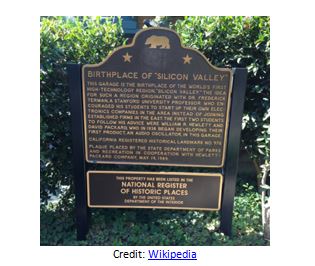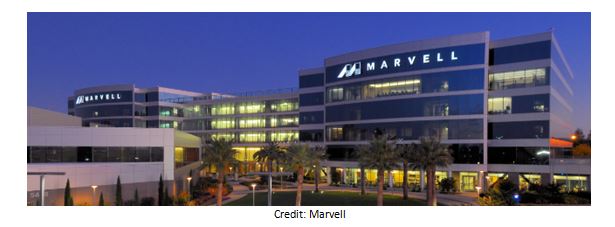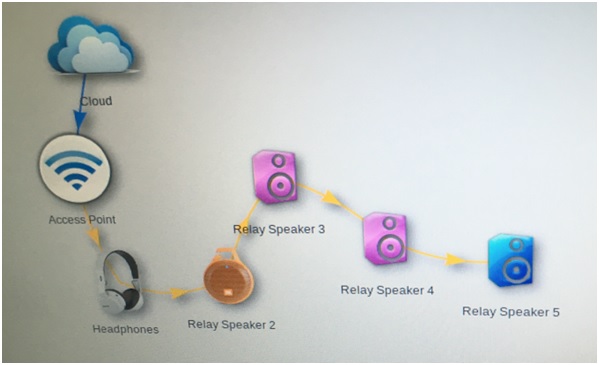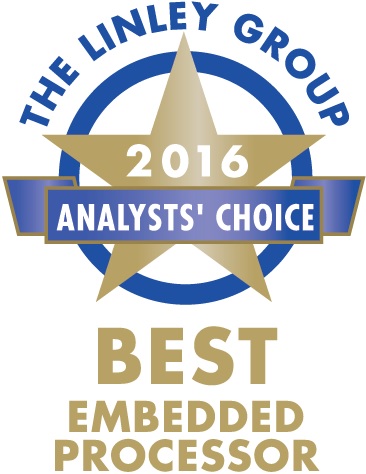

By Sander Arts, Interim VP of Marketing, Marvell
Before Silicon Valley became synonymous with high-tech and innovation, it was known as the “Valley of Heart’s Delight.” This expansive piece of land boasting acres of orchards just south of San Francisco would grow to become the future home to some of the world’s most innovative tech companies.  Looking back at the area’s history, it’s no surprise that it would someday inspire a culture where groundbreaking tech comes to life in a garage, college dorm room or even at a kitchen table. The story of Silicon Valley itself begins in a garage, with two Stanford grads William Hewlett and David Packard, who would later found Hewlett-Packard in 1939. Throughout the next decade, entrepreneurs and scientists would come to the Santa Clara Valley to explore radio, military and electronic technology, laying the groundwork for the future hotbed of innovation.
Looking back at the area’s history, it’s no surprise that it would someday inspire a culture where groundbreaking tech comes to life in a garage, college dorm room or even at a kitchen table. The story of Silicon Valley itself begins in a garage, with two Stanford grads William Hewlett and David Packard, who would later found Hewlett-Packard in 1939. Throughout the next decade, entrepreneurs and scientists would come to the Santa Clara Valley to explore radio, military and electronic technology, laying the groundwork for the future hotbed of innovation.  By 1953 notable tech companies began to officially establish ground in Santa Clara Valley with property in Stanford Industrial Park, closely followed by the area’s first semi company in 1956. With the Space Race in full force throughout the 1960s, the country experienced a heightened focus on the need for advanced silicon technologies and the valley began to take shape as the country’s hub for advanced high tech. Due to the sheer number of silicon companies in the park and growing attention on the semi industry, the area was officially coined “Silicon Valley” in an Electronic News series published in 1971.
By 1953 notable tech companies began to officially establish ground in Santa Clara Valley with property in Stanford Industrial Park, closely followed by the area’s first semi company in 1956. With the Space Race in full force throughout the 1960s, the country experienced a heightened focus on the need for advanced silicon technologies and the valley began to take shape as the country’s hub for advanced high tech. Due to the sheer number of silicon companies in the park and growing attention on the semi industry, the area was officially coined “Silicon Valley” in an Electronic News series published in 1971.
Over the next 30 years, some of the world’s most groundbreaking technology companies would make their way to Silicon Valley. Marvell officially became a part of the phenomenon in 1995, right in the middle of the dot.com bubble. Since then, we’ve seen firsthand how the tech scene has grown exponentially through innovation and entrepreneurship. The startup mentality that originated in 1939 and which continues to boom in the 21st century inspires us to continue improving, innovating and challenging technology of today. At Marvell, we are confident in our vision for the future of silicon, data and cloud technologies and look forward to being a part of the next generation of great entrepreneurs, thinkers and tinkerers in Silicon Valley. 
By Michael Zimmerman, Vice President and General Manager, CSIBU, Marvell
Over the last three decades, Ethernet has grown to be the unifying communications infrastructure across all industries. More than 3M Ethernet ports are deployed daily across all speeds, from FE to 100GbE. In enterprise and carrier deployments, a combination of pizza boxes — utilizing stackable and high-density chassis-based switches — are used to address the growth in Ethernet. However, over the past several years, the Ethernet landscape has continued to change. With Ethernet deployment and innovation happening fastest in the data center, Ethernet switch architecture built for the data center dominates and forces adoption by the enterprise and carrier markets. This new paradigm shift has made architecture decisions in the data center critical and influential across all Ethernet markets. However, the data center deployment model is different.
 Ethernet port deployment in data centers tends to be uniform, the same Ethernet port speed whether 10GbE, 25GbE or 50GbE is deployed to every server through a top of rack (ToR) switch, and then aggregated in multiple CLOS layers. The ultimate goal is to pack as many Ethernet ports at the highest commercially available speed onto the Ethernet switch, and make it the most economical and power efficient. The end point connected to the ToR switch is the server NIC which is typically the highest available speed in the market (currently 10/25GbE moving to 25/50GbE). Today, 128 ports of 25GbE switches are in deployment, going to 64x 100GbE and beyond in the next few years. But while data centers are moving to higher port density and higher port speeds, and homogenous deployment, there is still a substantial market for lower speeds such as 10GbE that continues to be deployed and must be served economically. The innovation in data centers drives higher density and higher port speeds but many segments of the market still need a solution with lower port speeds with different densities. How can this problem be solved?
Ethernet port deployment in data centers tends to be uniform, the same Ethernet port speed whether 10GbE, 25GbE or 50GbE is deployed to every server through a top of rack (ToR) switch, and then aggregated in multiple CLOS layers. The ultimate goal is to pack as many Ethernet ports at the highest commercially available speed onto the Ethernet switch, and make it the most economical and power efficient. The end point connected to the ToR switch is the server NIC which is typically the highest available speed in the market (currently 10/25GbE moving to 25/50GbE). Today, 128 ports of 25GbE switches are in deployment, going to 64x 100GbE and beyond in the next few years. But while data centers are moving to higher port density and higher port speeds, and homogenous deployment, there is still a substantial market for lower speeds such as 10GbE that continues to be deployed and must be served economically. The innovation in data centers drives higher density and higher port speeds but many segments of the market still need a solution with lower port speeds with different densities. How can this problem be solved?
Fortunately, the technology to bridge lower speed ports to higher density switches has existed for several years. The IEEE standards codified the 802.1br port extender standard as the protocol needed to allow a fan-out of ports from an originating higher speed port. In essence, one high end, high port density switch can fan out hundreds or even thousands of lower speed ports. The high density switch is the control bridge, while the devices which fan out the lower speed ports are the port extenders.
In addition to re-packaging the data center switch as a control bridge, there are several unique advantages for using port extenders:
Port extenders are only a fraction of the cost, power and board space of any other solution aimed for serving Ethernet ports.
Port extenders have very little or no software. This simplified operational deployment results in the number of managed entities limited to only the high end control bridges.
Port extenders communicate with any high-end switch, via standard protocol 802.1br. Additional options such as Marvell DSA, or programmable headers are possible.)
Port extenders work well with any transition service: 100GbE to 10GbE ports, 400GbE to 25GbE ports, etc.
Port extenders can operate in any downstream speed: 1GbE, 2.5GbE, 10GbE, 25GbE, etc.
Port extenders can be oversubscribed or non-oversubscribed, which means the ratio of upstream bandwidth to downstream bandwidth can be programmable from 1:1 to 1:4 (depending on the application). This by itself can lower cost and power by a factor of 4x.
Marvell has launched multiple purpose-built port extender products, which allow fan-out of 1GbE and 10GbE ports of 40GbE and 100GbE higher speed ports. Along with the silicon solution, software reference code is available and can be easily integrated to a control bridge. Marvell conducted interoperability tests with a variety of control bridge switches, including the leading switches in the market. The benchmarked design offers 2x cost reduction and 2x power savings. SDK, data sheet and design package are available. Marvell IEEE802.1br port extenders are shipping to the market now. Contact your sales representatives for more information.
By Jawad Haider, Senior Product Marketing Manager of Wireless Connectivity Business Unit, Marvell
As chips are becoming smaller and more powerful, the wireless audio market is continuing to rapidly grow. According to MarketsandMarkets, the wireless audio industry is expected to reach $54.07 billion by 2022, at a CAGR of 23.2 percent between 2016 and 2022. High performance, low power wireless and Bluetooth/ Bluetooth Low Energy (BLE) solutions have been key enablers of the growth of wireless audio, providing the technology for companies to develop connected audio solutions that have the throughput and range needed for high-resolution wireless, integrated with the extended battery life consumers expect for portable devices.
Multi-channel and multi-room wireless audio solutions are two key trends that have seen an increase in consumer adoption. However, to enable consumers to seamlessly stream their favorite tunes throughout their homes, there are a few key technological challenges with range and synchronization that must be addressed.
Marvell’s newest Avastar® wireless connectivity solutions make range limitations a thing of the past for many home and enterprise audio applications. Marvell’s high performance and low power Avastar combos incorporate Dynamic Multi-Hop Relay (DMHR) Technology to connect up to 15 devices in a daisy-chain fashion, extending the range of traditional Wi-Fi networks 15 times from 40m to almost 600m in a typical home. Additionally, Marvell has enabled other exciting features, such as connecting up to 31 clients to a speaker or sound bar which acts as a soft access point.  Diagram showing a daisy-chain wireless audio setup
Diagram showing a daisy-chain wireless audio setup
To make every microsecond of audio count, Marvell’s Avastar solutions provide cutting-edge audio synchronization across devices and rooms. Combining Marvell’s advanced Wi-Fi technology, support for the 802.11mc standard, and hardware time-stamping synchronization algorithms developed by our partners, Avastar delivers best-in-class smart connected solutions.
Another key trend in the wireless audio space, is the emergence of voice assisted products like Amazon Echo and Google Home. Marvell is working closely with all voice-enabled ecosystems to be at the forefront of technology enablement for this new category of products.
From portable speakers to advanced soundbar systems, Marvell’s advanced wireless technology is embedded in many of the most popular audio products on the market today. To learn more about Marvell’s wireless solutions, please visit: www.marvell.com/wireless. You can also read more about wireless trends and standards in my Q&A with Electronic Design’s Bill Wong http://electronicdesign.com/wifi/qa-what-s-new-wireless-audio-market.
By Sander Arts, Interim VP of Marketing, Marvell
 We are only a couple of weeks into the New Year and already have a glimpse of how the industry will take shape in 2017 and beyond. It has been a ritual for the Marvell team, and most major players in the technology ecosystem, to start the first week of the year showcasing the cutting-edge solutions of today and tomorrow at CES. This year, the Las Vegas expo floor showed us that everyday objects, as well as cars, are getting smarter and are taking on new capabilities, signaling new demands for the industry to address.
We are only a couple of weeks into the New Year and already have a glimpse of how the industry will take shape in 2017 and beyond. It has been a ritual for the Marvell team, and most major players in the technology ecosystem, to start the first week of the year showcasing the cutting-edge solutions of today and tomorrow at CES. This year, the Las Vegas expo floor showed us that everyday objects, as well as cars, are getting smarter and are taking on new capabilities, signaling new demands for the industry to address.
The race to fully autonomous cars continues with new automotive tech ranging from improved sensors for Advanced Driver Assistance Systems (ADAS) to new displays and infotainment systems. Automakers introduced the integration of cloud-based voice assistants, which is bound to revolutionize the way we will interact with our cars.
Virtual reality (VR) developers focused on creating better content and tools to bring VR to the mainstream. Companies shared plans for gesture tracking and untethered headsets to deliver immersive experiences for gaming, entertainment and enterprise applications. In the near future, we can expect access to more VR, augmented reality (AR) and mixed reality (MR) content and experiences, such as shopping in virtual retail stores.
While automotive tech and VR continued to have a big presence at CES like in past years, artificial intelligence (AI) was one of the stars of the show. We saw more devices—beyond robots and smartphones—touting AI capabilities as automakers and home appliance manufacturers showcased exciting voice control integrations in cars, fridges, washing machines, TVs and more.
Amid all of the hype around the technologies that took center stage at this year’s CES, it was clear that data remains at the heart of our connected world. With advancements in connectivity comes the explosion of digital traffic as data is created, accessed, stored and moved to the cloud by billions of connected devices, appliances, cars, enterprises and more. Autonomous cars, VR and AI all depend on high bandwidth video and data to deliver smart and seamless experiences for consumers.  At CES Marvell demonstrated how we are enabling the ecosystem to overcome its toughest data storage and network bandwidth challenges with our advanced solutions for the cloud, automotive, industrial, enterprise and consumer markets. Our automotive Ethernet physical layer (PHY) transceiver provides the robust 1000BASE-T1 connectivity needed to distribute data between the multiple advanced in-vehicle systems of tomorrow’s cars.
At CES Marvell demonstrated how we are enabling the ecosystem to overcome its toughest data storage and network bandwidth challenges with our advanced solutions for the cloud, automotive, industrial, enterprise and consumer markets. Our automotive Ethernet physical layer (PHY) transceiver provides the robust 1000BASE-T1 connectivity needed to distribute data between the multiple advanced in-vehicle systems of tomorrow’s cars.
As data is moved and stored from consumer devices to the cloud, data centers can take advantage of our support for a range of Ethernet technology speeds for even greater accessibility, including our Prestera® switches, Alaska® Ethernet transceivers and ARMADA® 64-bit ARM-based modular SoC families for 10 Gigabit Ethernet (GbE), 25 GbE and 40 GbE. We also demonstrated at CES our recently announced 25GbE end-to-end data center solution which underscores our commitment to delivering high performance, cost-effective and energy-efficient computing solutions to keep up with today’s increasing bandwidth demands.
What we saw at CES validates the work we do at Marvell, providing industry-leading solutions that help our customers move and store data fast, securely, reliably and efficiently across a wide range of applications, systems and platforms. For whatever new demands and challenges the market brings in 2017, Marvell is on the Move. We are only a couple of weeks into the New Year and already have a glimpse of how the industry will take shape in 2017 and beyond. It has been a ritual for the Marvell team, and most major players in the technology ecosystem, to start the first week of the year showcasing the cutting-edge solutions of today and tomorrow at CES. This year, the Las Vegas expo floor showed us that everyday objects, as well as cars, are getting smarter and are taking on new capabilities, signaling new demands for the industry to address.
The race to fully autonomous cars continues with new automotive tech ranging from improved sensors for Advanced Driver Assistance Systems (ADAS) to new displays and infotainment systems. Automakers introduced the integration of cloud-based voice assistants, which is bound to revolutionize the way we will interact with our cars.
Virtual reality (VR) developers focused on creating better content and tools to bring VR to the mainstream. Companies shared plans for gesture tracking and untethered headsets to deliver immersive experiences for gaming, entertainment and enterprise applications. In the near future, we can expect access to more VR, augmented reality (AR) and mixed reality (MR) content and experiences, such as shopping in virtual retail stores.
By Marvell PR Team
 We pride ourselves on delivering innovative solutions to help our global customers store, move and access data—fast, securely, reliably and efficiently. Underscoring our commitment to innovation, we were named one of the Top 100 Global Innovators by Clarivate Analytics for the fifth consecutive year. In further recognition of our world-class technology, we are excited to share that The Linley Group, one of the most prominent semiconductor analyst firms, has selected Marvell’s ARMADA® SP (storage processor) as the Best Embedded Processor in its 2016 Analysts' Choice Awards.
We pride ourselves on delivering innovative solutions to help our global customers store, move and access data—fast, securely, reliably and efficiently. Underscoring our commitment to innovation, we were named one of the Top 100 Global Innovators by Clarivate Analytics for the fifth consecutive year. In further recognition of our world-class technology, we are excited to share that The Linley Group, one of the most prominent semiconductor analyst firms, has selected Marvell’s ARMADA® SP (storage processor) as the Best Embedded Processor in its 2016 Analysts' Choice Awards.
Honoring the best and the brightest in semiconductor technology, the Analysts' Choice Awards recognize the solutions that deliver superior power, performance, features and pricing for their respective end applications and markets. The Linley Group awarded this prestigious accolade to Marvell for its ARMADA SP and recognized the solution’s high level of integration, high performance and low-power operation.
Marvell’s ARMADA SP is optimized for the rapid development of high-efficiency and high-density storage solutions for the enterprise and data center markets. With a highly integrated, scalable and flexible architecture, the ARMADA SP incorporates state-of-the-art interfaces and acceleration engines for advanced data processing capabilities, and to support TCO-minded hyperscale environments.
To learn more about Marvell’s SP solution, visit: http://www.marvell.com/storage/armada-sp/.